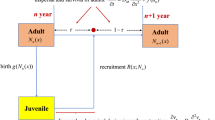Abstract
The problem of creating a new method of computational modeling of variable growth rate for biological species with a pronounced staging of the life cycle is considered. In situations with metamorphoses, growth is not constant and depends on the stages of development, but reaching a new stage is possible for an organism while maintaining a normal growth rate. Transitions between stages of development and changes in the growth rate are interdependent phenomena that require special modeling methods. An indicator of the growth rate of organisms is a key characteristic that directly affects the success of the transition to the next ontogenetic stage and does so indirectly through the mechanism of intraspecific competition, and so the survival of the entire new generation. The hybrid model with event time developed by the author takes into account that rapid ecological and physiological metamorphoses in the development of organisms are reflected in the factors regulating the final number of the adult part of the population, for example, insects with an incomplete transformation cycle. The rate of development fluctuates significantly until the moment of maturation in many species of insects with a high reproductive potential. The staging is important for migratory fish, and it is not reflected by the generalized function of L. von Bertalanffy, since it depends on the degree of competition. A method is proposed for describing the rate of growth with changes as a continuous-discrete computational structure based on differential equations in the Cauchy form with a predicatively redefined right-hand side structure. An iterative dynamic system of the population process is obtained, which has the ability to change coexisting stable cycles under the influence of external factors. In the case of strengthening competitive factors due to natural causes, a reverse tangential bifurcation occurs and the stability of the system is destroyed. The alternative attractor in the form of a cycle with the highest average abundance value disappears, the population goes into a long depression mode. The model is interesting for discussing the problem of sympatric speciation as an evolutionary trend with the emergence of closely related species in one area in order to reduce their competition for resources needed for life.






Similar content being viewed by others
REFERENCES
A. V. Nikitina, A. I. Sukhinov, G. A. Ugolnitsky, A. B. Usov, A. E. Chistyakov, M. V. Puchkin, and I. S. Semenov, Math. Models Comput. Simul. 9, 101 (2017).
A. N. Frolov, Entomol. Rev., No. 2, 147 (2015).
L. R. Clark, Aust. J. Zool. 12 (3), 362 (1964).
W. Ricker, J. Fish. Res. Board Can., No. 11, 559 (1954).
J. Guckenheimer, Commun. Math. Phys. 70, 133 (1979).
M. Feigenbaum, Phys. D 7, 16 (1983).
A. N. Sharkovskii, Int. J. Bifurcation Chaos Appl. Sci. Eng. 5, 1263 (1995).
R. P. Khodorevskaya and V. A. Kalmykov, J. Ichthyol. 54 (8), 576 (2014).
G. N. Panin, R. M. Mamedov, and I. V. Mitrofanov, The Current State of the Caspian Sea (Nauka, Moscow, 2005) [in Russian].
M. I. Legeza and R. A. Mailyan, To the methodology of the study of the number of sturgeon in the Caspian Sea, in Theses of the Reporting Session of the TsNIORKh (Astrakhan’, 1974), p. 82 [in Russian].
Y. N. Perevaryukha, Present status of Caspian sturgeons, biodiversity and some problems of their specific identification by molecular genetic, including caviar, in Proc. 4th Int. Symp. on Sturgeon (Oshkosh, Wisconsin, USA, July 8–13, 2001).
J. Hoyle, Status of Lake Whitefish (Coregonus clupeaformis) in Lake Ontario and the response to the disappearance of Diporeia spp., in Proc. Workshop on the Dynamics of Lake Whitefish (Coregonus Clupeaformis) in the Great Lakes (2005), p. 47.
F. Courchamp, B. Ludek, and J. Gascoigne, Allee Effects in Ecology and Conservation (Oxford Univ. Press, New York, 2008).
E. N. Artyukhin, Sturgeon Q. 3 (2), 6 (1995).
I. M. Anisimova and V. V. Lavrovskii, Ichthyology (Vysshaya Shkola, Moscow, 1983) [in Russian].
G. D. Ryabova, Russ. J. Genet. 42 (2), 182 (2006).
L. Von Bertalanffy, Q. Rev. Biol. 32, 217 (1957).
A. Y. Perevaryukha, Biophysics 61 (2), 334 (2016).
P. V. Veshchev and G. I. Guteneva, Russ. J. Ecol. 43 (2), 142 (2012).
Y. N. Perevaryukha, P. P. Geraskin, and T. Y. Perevaryukha, J. Ichthyol. 51 (5), 392 (2011).
A. Y. Perevaryukha, Entomol. Rev. 95 (3), 397 (2015).
A. Y. Perevaryukha, Biophysics 65 (1), 118 (2020).
A. Y. Perevaryukha, Biophysics 66 (2), 327 (2021).
Author information
Authors and Affiliations
Corresponding author
Additional information
Translated by M. Drozdova
Rights and permissions
About this article
Cite this article
Perevaryukha, A.Y. Mathematical Modeling of Changes in the Growth Rate at the Early Stages of Development of Organisms for Biological Species with Metamorphosis in Ontogenesis. Tech. Phys. 67, 651–660 (2022). https://doi.org/10.1134/S1063784222090043
Received:
Revised:
Accepted:
Published:
Issue Date:
DOI: https://doi.org/10.1134/S1063784222090043




